Archive for August, 2009
4-Lane Bridges (4-line Hashi)
Aug 29th
I’ve been on holiday, so sorry for the lack of posts. But, very quickly, here’s a 4-way Hashi for you! ![]() Connect no more than 4 bridges between any pair of horizontally or vertically neighbouring islands.
Connect no more than 4 bridges between any pair of horizontally or vertically neighbouring islands.
Good luck! ![]()
Hashi variation – 3-lines
Aug 14th
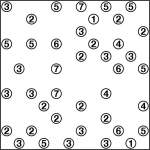
Hashi-3 12×12 puzzle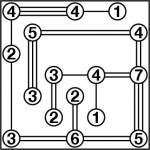
Hashi-3 example solution
I’ve been discussing Hashi variations in the comments to a previous posting, so I thought I’d try out one of them today. This is not a brand new variation because it’s a somewhat obvious change, but it’s not very commonly seen even so.
In this version of Hashi you must place no more than 3 lines between any two islands (as opposed to the restriction to no more than 2 lines in regular Hashi). The full rules, then, are:
- Each circle represents an island. You must draw bridges between islands to connect all of the islands together, so you can travel from any given island to any other island just by crossing bridges.
- Bridges can only be placed in exactly horizontal or vertical directions
- Bridges cannot cross over any islands – when they reach an island they must stop
- Each island must have the number of bridges connected to it specified by the number on the island
- There can be no more than 3 direct bridges between any 2 islands.
Take a look at the example puzzle, which shows how Hashi-3 (anyone got a suggestion for a better name?!) works.
This puzzle is difficult – it will probably take you a good 15 minutes, despite its size – but see how you find it! ![]()
Hashi 30×20
Aug 12th
Larger puzzles tend to be a bit trickier just because there are more places to look at, so I thought a moderate-rated 30×20 Hashi puzzle could be interesting. You can of course make Hashi puzzles as large as you like, but the problem is keeping them fun by mixing in difficult parts with easier parts (as this 30×20 might possibly demonstrate!).
The rules of Hashi are pretty simple – check back a few days for full instructions and an example puzzle.
Good luck! ![]()
More Hashi
Aug 9th
Following up Friday’s first Hashi puzzle here, I thought I’d post a somewhat trickier example. It’s fairly straightforward until you’re nearly finished, then you’ll have to think just a little bit to complete the puzzle.
For full instructions, please see my previous post.
Good luck! ![]()
Hashi / Bridges
Aug 7th
I haven’t posted a Hashi (aka Bridges) puzzle before, partially because until yesterday I had never got round to writing a program to draw the PDFs – and drawing them out in Illustrator is a little bit time-consuming, so I had kept my Hashi production to the bare minimum. But now I’ve changed that, having automated much more of the process. And so here’s the first result of that, an easy (albeit quite large) Hashi puzzle to start the ship sailing (or ball rolling or whatever your metaphor of choice is).
This puzzle is interchangeably called either by its Japanese name of Hashi or Hashiwokakero, or by its Western name of Bridges. It’s probably easier to give an overview of what you have to do using the Bridges metaphor (it’s clearly a day for metaphors):
- Each circle represents an island. You must draw bridges between islands to connect all of the islands together, so you can travel from any given island to any other island just by crossing bridges.
- Bridges can only be placed in exactly horizontal or vertical directions
- Bridges cannot cross over any islands – when they reach an island they must stop
- Each island must have the number of bridges connected to it specified by the number on the island
- There can be no more than 2 direct bridges between any 2 islands.
So for example a ‘4′ island in a corner would have to have 2 bridges travelling away from it on each of the two sides it can connect, and two ‘1′ islands next to one another could not connect because they would then be isolated from the rest of the islands.
I’ve included a small example solution here too, so take a look at that if the rules aren’t entirely clear.
Hashi itself is generally relatively easy compared to many other Japanese puzzles, although it is possible to make large puzzles which are pretty tricky – working out how areas are isolated, and must force other bridges, can be quite complex. But by and large the puzzles are pretty straightforward, as perhaps you’ll find with today’s (admittedly rated ‘easy’) puzzle.
Good luck! ![]()
More Diagonal Numberlink
Aug 5th

Diagonal Number Link 8×5 puzzle 2
Diagonal Number Link 8×5 puzzle 1
Here’s two more, slightly larger, diagonal number link puzzles – these are 8×5. The problem with diagonal number link is that it’s very hard to constrain the puzzles to a unique solution without making them really quite easy, since lines essentially can’t run parallel for more than a couple of squares, otherwise they could swap over and back and produce at least two different solutions.
So in fact once you get over the slight confusion of diagonal lines, diagonal number link actually turns out to be easier I think, and these two puzzles do demonstrate the relatively easy nature – they can both be solved logically without too much effort. However I found them quite fun, none the less!
The finished puzzles look good though – all those diagonal lines make it seem as if you’ve just solved something really tricky… ![]()
Please see previous posts for the rules of number link and diagonal number link.
Diagonal Number Link!
Aug 4th
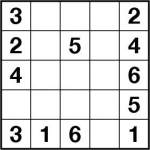
Diagonal Number Link 5×5 puzzle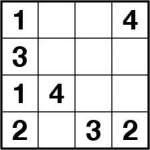
Diagonal Number Link 4×4 puzzle
If you thought toroidal number link was tricky, then how about diagonal number link?! In this variant the rules are exactly the same but now you can use diagonal lines as well as horizontal and vertical lines! The diagonal lines can only travel between diagonally-adjacent (diagonally touching) squares, and diagonal lines are allowed to cross. This is because the Number link rule is that “each square can only have a single line in it” – in the case of diagonal numberlink this does actually allow the lines to cross at the corner of certain squares. So just draw one line per pair of identical numbers, linking them together. In the unique solution all squares are used.
The first 4×4 puzzle is very easy but despite being very easy it’s still a bit confusing to actually solve, so I’d suggest trying it first.
The 5×5 puzzle isn’t exactly difficult either, but it might at least give you a minute or so of amusement! I found it quite interesting to solve at least.
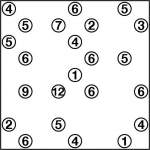
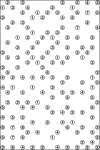
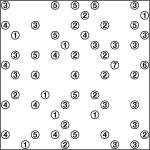
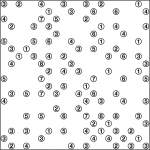
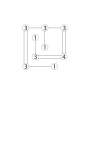

Recent Comments